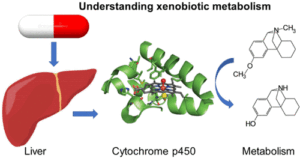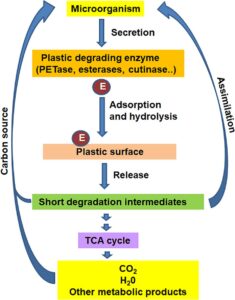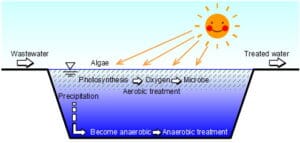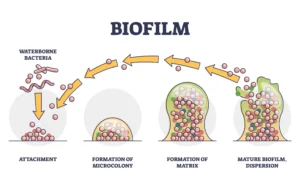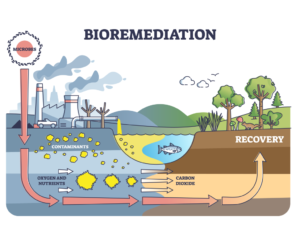The biological wastewater treatment process is based on the natural ability of microorganisms to break down organic matter in wastewater into simpler substances such as carbon dioxide, water, and biomass. Microorganisms, including bacteria, fungi, and protozoa, use organic compounds in wastewater as a source of energy and nutrients for their growth.

Steps in Wastewater Treatment
Wastewater treatment typically involves three stages:
- Primary Treatment
- Secondary Treatment
- Tertiary Treatment
1. Primary Treatment
Primary treatment focuses on the removal of physical contaminants from wastewater. This stage primarily addresses the removal of suspended solids, oils, greases, and other large debris.
Processes in Primary Treatment:
- Screening
- Removes large objects such as plastics, rags, sticks, and other debris that could damage or clog downstream equipment.
- Neutralization
- Adjusts the pH of wastewater to a neutral level (pH 6-9) to prevent damage to treatment equipment and downstream ecosystems.
- Equalization
- Stabilizes fluctuations in flow and contaminant concentrations to ensure a consistent and manageable feed to the next treatment stages.
- Sedimentation
- Allows suspended solids to settle out by gravity in primary settling tanks. The heavier particles settle to the bottom, forming sludge, while lighter solids float as scum, which is later removed.
- Coagulation
- Adds coagulants (e.g., alum or ferric chloride) to wastewater, which binds small particles and impurities into larger particles (flocs) that can then be removed through sedimentation or filtration.
Key Outputs:
- Sludge
- Effluent with reduced suspended solids and organic matter
2. Secondary Treatment
Secondary treatment focuses on the biological breakdown of organic matter and nutrients. It is designed to further purify the wastewater by removing dissolved and suspended pollutants.
Processes in Secondary Treatment:
- Trickling Filter
- Wastewater is sprayed over a bed of stones or plastic media covered with biofilm. Microorganisms in the biofilm degrade organic matter as the water passes through.
- Anaerobic Digestion
- Organic matter is decomposed by anaerobic bacteria in the absence of oxygen. This process produces methane gas as a byproduct and significantly reduces the organic load.
- Oxidation Ditch
- A continuous-flow, aerated channel where microorganisms degrade organic matter. Aeration keeps the environment oxygen-rich to facilitate microbial respiration.
- Aerated Lagoon
- A shallow pond where wastewater is aerated, encouraging biological decomposition of organic matter by bacteria and other microorganisms.
- Activated Sludge Process
- Wastewater is mixed with activated sludge (a concentrated suspension of microorganisms) in an aeration tank. Microorganisms consume organic matter, which is then settled in secondary clarifiers as activated sludge.
- Oxidation Pond
- A shallow man-made pond where natural sunlight and microbial activity break down organic pollutants. It’s often used for smaller-scale or decentralized treatment.
Key Outputs:
- Effluent with significantly reduced BOD, COD, and suspended solids
- Sludge from secondary clarifiers
3. Tertiary Treatment
Tertiary treatment focuses on the removal of specific pollutants to achieve a high-quality effluent suitable for discharge into the environment or for reuse.
Processes in Tertiary Treatment:
- Reverse Osmosis (RO)
- A highly effective filtration process where water is forced through semi-permeable membranes, removing dissolved salts, heavy metals, and other contaminants.
- Chemical Precipitation
- Removes excess nutrients (e.g., phosphorus and nitrogen) through the addition of chemicals like alum or ferric chloride, which form insoluble precipitates that can be removed.
- Evaporation
- A process where water is evaporated, leaving behind concentrated pollutants, which are then managed separately. Often used for wastewater with high levels of dissolved salts or other inorganic pollutants.
- Removal by Algae
- Algae or other aquatic plants are used to treat wastewater, particularly for nutrient removal. Algae take up nitrogen and phosphorus while oxygenating the water through photosynthesis.
- Activated Carbon
- A highly porous material used to adsorb organic compounds, odors, and trace contaminants. Activated carbon filters are effective for reducing pollutants like pesticides, volatile organic compounds (VOCs), and color.
- Resin Exchange
- Uses ion-exchange resins to remove specific ions from wastewater, such as heavy metals, sodium, or other dissolved salts, providing high-purity water.
Key Outputs:
- High-quality treated effluent
- Minimal environmental impact
- Reusable water for industrial, agricultural, or recreational purposes
Comparison of Treatment Stages:
| Stage | Primary Treatment | Secondary Treatment | Tertiary Treatment |
|---|---|---|---|
| Goal | Physical removal of solids, oils, and greases | Biological degradation of organic matter and nutrients | Advanced removal of specific contaminants |
| Processes | Screening, sedimentation, coagulation | Trickling filter, activated sludge, anaerobic digestion | Reverse osmosis, chemical precipitation, activated carbon |
| Output | Sludge, treated effluent | Effluent with reduced BOD, COD, suspended solids | High-quality effluent for discharge or reuse |
Primary, secondary, and tertiary treatments are sequential stages of wastewater treatment that progressively remove contaminants from wastewater. Each stage plays a critical role in achieving environmental safety standards and ensuring the sustainability of water resources.

